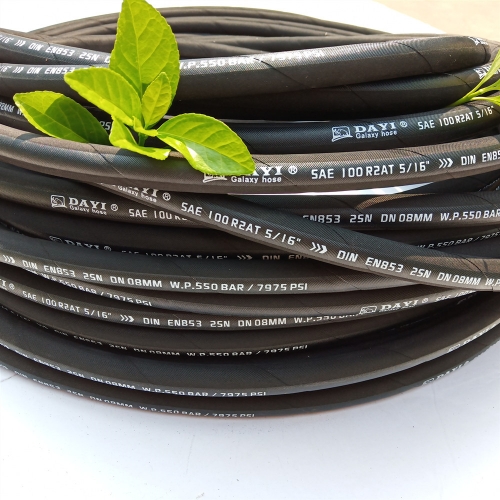335345435
Oct . 05, 2024 16:56 Back to list
Components and Materials Used in Hydraulic Hose Manufacturing
What is Hydraulic Hose Made Of?
Hydraulic hoses are essential components in various machinery and equipment that rely on hydraulic systems. They facilitate the transfer of hydraulic fluid which powers the equipment. Understanding what hydraulic hoses are made of is crucial for ensuring their proper functionality and longevity.
A hydraulic hose is primarily composed of three main parts the inner tube, reinforcement layers, and the outer cover. Each of these components plays a vital role in the hose's overall performance and durability.
1. Inner Tube The inner tube is the most critical component of a hydraulic hose since it directly transports the hydraulic fluid. This tube is usually made from synthetic rubber, thermoplastic, or a combination of both. The materials are chosen based on their compatibility with the type of hydraulic fluid being used, as well as their ability to withstand high pressure and temperature. The inner tube must also exhibit excellent resistance to wear and abrasion, ensuring that it maintains its integrity under harsh operating conditions.
what is hydraulic hose made of

2. Reinforcement Layers Surrounding the inner tube are one or more reinforcement layers. These layers provide additional strength to the hose and are usually made from materials like steel wire, fiber, or textile. Steel wire reinforcement is common in high-pressure hydraulic hoses, providing significant tensile strength and allowing the hose to withstand extreme pressure without bursting. Some hoses may also utilize spiral wire or braided wire configurations for added support. Textile fibers can be included for lower-pressure applications, offering flexibility and lightweight properties.
3. Outer Cover The outer cover of a hydraulic hose protects the inner components from environmental factors such as UV exposure, abrasion, and chemicals. This cover is typically made from rubber or thermoplastic materials that are resistant to oil, heat, and ozone. The design and material of the outer cover can vary based on the intended use of the hose. For instance, hoses used in industrial settings may require more robust covers to withstand harsh conditions, while those used in automotive applications may prioritize flexibility and ease of handling.
In addition to these three primary components, hydraulic hoses can also be equipped with various fittings and connectors that ensure secure attachment to machinery and prevent leaks. The quality of these additional components is crucial, as they must endure the same pressures and conditions as the hose itself.
In conclusion, hydraulic hoses are intricate assemblies made of several specialized materials engineered to operate efficiently in high-pressure environments. Their construction includes an inner tube, reinforcement layers, and an outer cover, all designed to work together seamlessly. Choosing the right hydraulic hose for specific applications is essential for maintaining operational safety and efficiency. Regular inspection and maintenance can also help prolong the lifespan of hoses, ensuring that machinery continues to function effectively. Understanding the composition of hydraulic hoses can aid in making informed decisions regarding their selection and maintenance.
-
SAE 100 R17 Black Smooth Cover Hydraulic Hose
NewsMar.07,2025
-
SAE 100 R17 Black Smooth Cover Hydraulic Hose
NewsMar.07,2025
-
SAE 100 R17 Black Smooth Cover Hydraulic Hose
NewsMar.07,2025
-
SAE 100 R17 Black Smooth Cover Hydraulic Hose
NewsMar.07,2025
-
SAE 100 R17 Black Smooth Cover Hydraulic Hose
NewsMar.07,2025
-
steel wire braided hydraulic hose
NewsMar.07,2025



